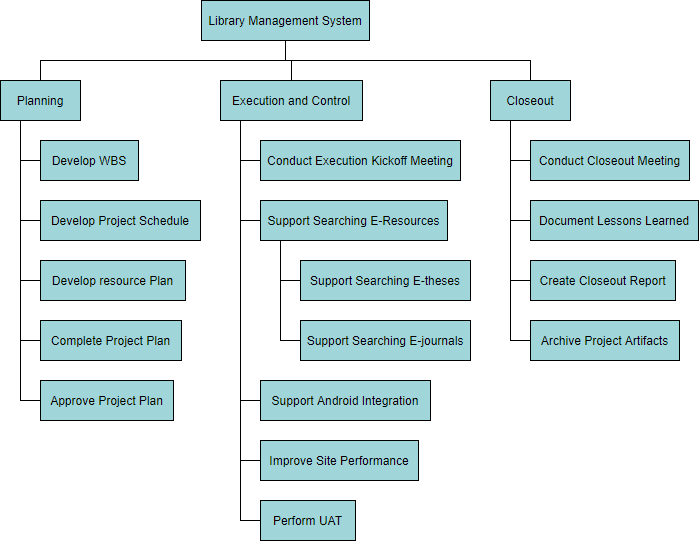A work breakdown structure (WBS) is a key project deliverable that organizes the team’s work into manageable sections. The work breakdown structure is a hierarchical decomposition of the total scope of work to be carried out by the project team to accomplish the project objectives and create the required deliverables. A WBS also provides the necessary framework for detailed cost estimating and control along with guiding schedule development and control.

Edit this Work Breakdown Structure example
Benefits of Work Breakdown Structure
Work breakdown structure (or WBS) is a hierarchical tree structure that outlines your project and breaks it down into smaller, more manageable portions. It is a useful way to divide and conquer large projects so you can get things done faster and more efficiently.
The work breakdown structure has several benefits in addition to defining and organizing the project work. By allocating time and cost estimates to specific sections of the work breakdown structure, a project schedule and budget can be quickly developed. As the project executes, specific sections of the work breakdown structure can be tracked to identify project cost performance and identify issues and problem areas in the project organization.
The benefits of creating a WBS include:
- it provides a visual of the entire scope
- it defines and organizes the work required
- it facilitates the quick development of a schedule by allocating effort estimates to specific sections of the WBS
- it can be used to identify potential scope risks if it has a branch that is not well defined\
- it can show control points and milestones
- it provides a tool for team brainstorming and collaboration
Work Breakdown Structure is often used in conjunction with other breakdown structures such as cost, risk or resources, etc.
- it provides a way to estimates project costs
- it can assist with resource allocation
- it can help to identify risks associated with the tasks or activities
How to Create a Work Breakdown Structure?
Work breakdown structure outlines your project and breaks it down into smaller, more manageable portions. To create a work breakdown structure, the project manager, together with the team and any client, should identify the most important pieces of scope.
A WBS helps to decompose a project into a hierarchy of phases, deliverable networks, and work packages. A WBS is arrived upon by successively decomposing the project Scope into ever more specific and granular phases and steps. Once a WBS Element cannot be decomposed any further, the WBS has arrived at the Work Package or ATOMIC Task level. Ultimately, the WBS is a tree-like structure that clearly shows the relationships and subdivisions required to achieve the Scope. The steps below outline the major steps to take in creating a Work Breakdown Structure.
- Define the scope of the project on the first level of the WBS
- Project management deliverables should be outlined at level two of the WBS
- Decompose project deliverables into work packages, to a level that can be scheduled, cost estimated, monitored, and controlled
- Apply the WBS to schedule development and resource assignment
- Apply the WBS to, as needed, change control, risk, budget, cost, and communication management, etc.